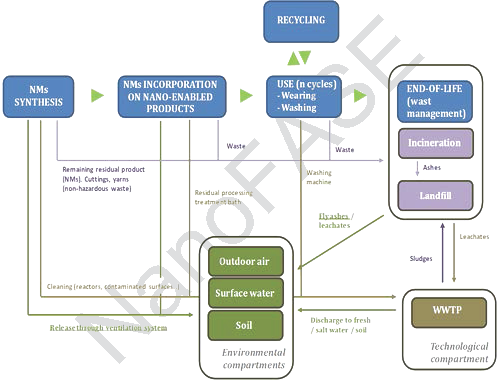WP4
Release forms and quantities from product life cycle
Lead: Socorro Vázquez-Campos, LEITAT Technological Center
The overall aim of WP4 is to identify and quantify engineered nanomaterials (ENMs) releases at all stages of nano-enabled product value chain (including accidents). This will provide relevant inputs in terms of ENMs forms and amounts entering either to waste handling and recycling facilities or directly to the different environmental compartments of air, soil or water.
The first step is the development of an emission database of the sectors/categories with higher potential of ENMs release to the environment, considering the life cycle phases (production, use, recycling, end-of-life), the temporal release profiles (month, week, day) and spatial distribution proxies. This is accomplished by using literature and web-based searches combined with data arising from ongoing and concluded European, international and national projects. Estimates are ground-truthed through direct interviews with industries, suppliers and customers.

Flow diagram exemplifying the entire life cycle of nano-enabled textiles
Secondly, in order to evaluate the release of ENM during synthesis and nano-enabled products manufacturing processes, data from field campaigns at industrial sites is collected. Furthermore, ENM emissions from plants to wastewater and solid wastes are quantified and samples are collected for characterization to identify released ENM forms. Moreover, to study the use phase of nano-enabled products, different simulation set-ups are designed case by case based on identified processes that will potentially lead to ENM emissions during nano-enabled product use. The designed setups include modifications of standardized protocols to collect released ENM for their consequent quantification and characterization. Releases during nano-enabled product recycling processes are studied by simulating some traditional recycling processes (e.g. plastics re-manufacturing or building materials for road building). To determine the accidental release of ENM to the environment, typical accident scenarios along the value chain (ENM production, post manufacturing, handling and transport) are studied and described in qualitative terms by considering various features (e.g. concentration, frequency). A catalogue of accidental release scenarios is established based on the orders of magnitude of loss of containment.
The release database is converted into a model based on the predictive release design including variations of material form and volume of the ENM release. Efforts focus on a geographical, temporal and complete probabilistic and stochastic model dynamization that captures the uncertainties and variability of the predicted release spectrum.

Washing process of nano-enabled textiles to evaluate the release during the use phase
